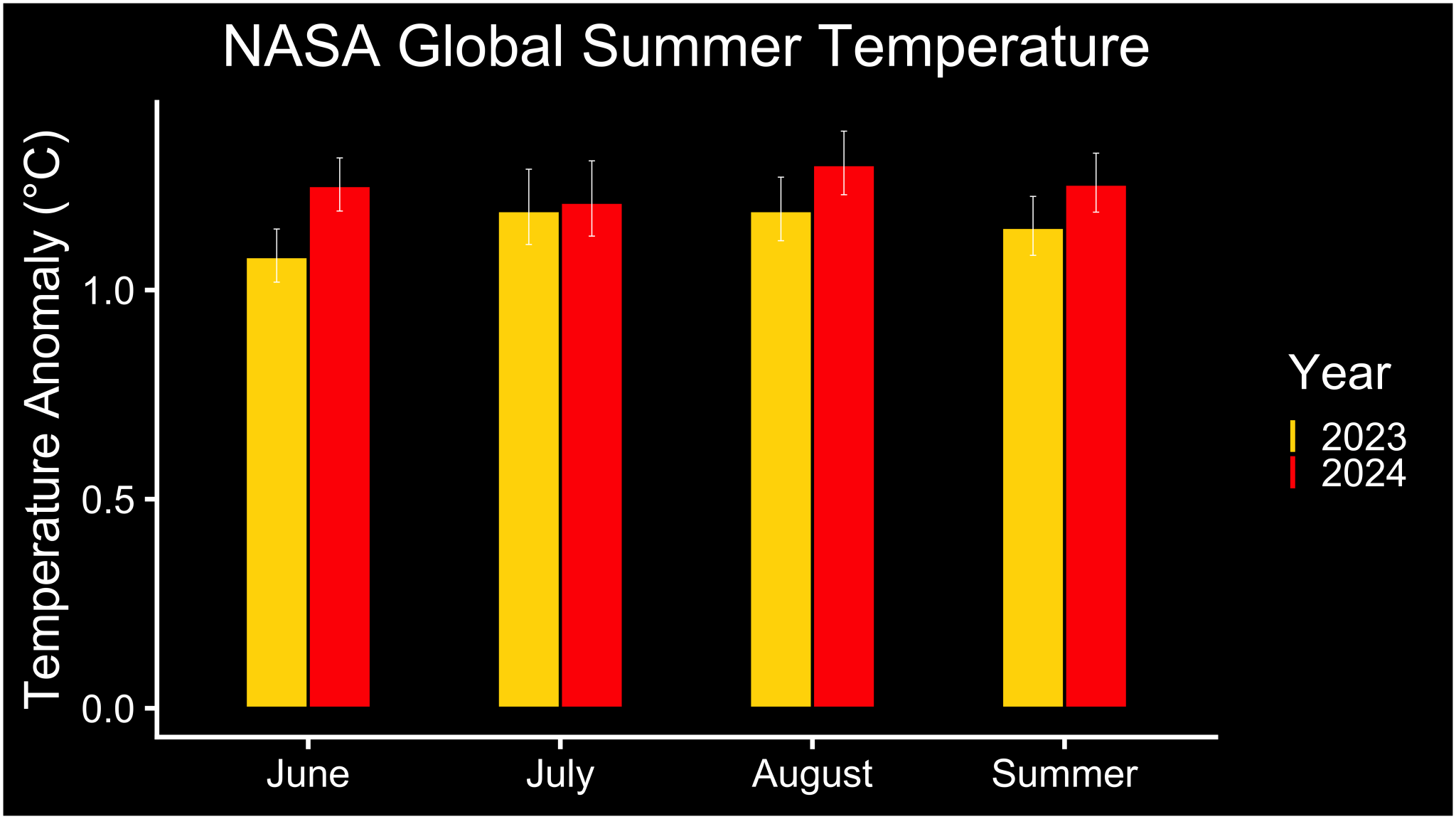2024-09-11 NASA
 This bar graph shows GISTEMP summer global temperature anomalies for 2023 (shown in yellow) and 2024 (shown in red). June through August is considered meteorological summer in the Northern Hemisphere. The white lines indicate the range of estimated temperatures. The warmer-than-usual summers continue a long-term trend of warming, driven primarily by human-caused greenhouse gas emissions.
This bar graph shows GISTEMP summer global temperature anomalies for 2023 (shown in yellow) and 2024 (shown in red). June through August is considered meteorological summer in the Northern Hemisphere. The white lines indicate the range of estimated temperatures. The warmer-than-usual summers continue a long-term trend of warming, driven primarily by human-caused greenhouse gas emissions.
NASA/Peter Jacobs
<関連情報>
- https://www.nasa.gov/earth/nasa-finds-summer-2024-hottest-to-date/
- https://agupubs.onlinelibrary.wiley.com/doi/10.1029/2023JD040179
NASAのGISTEMPv4観測不確実性アンサンブル A NASA GISTEMPv4 Observational Uncertainty Ensemble
Nathan Lenssen, Gavin A. Schmidt, Michael Hendrickson, Peter Jacobs, Matthew J. Menne, Reto Ruedy
Journal of Geophysical Research: Atmospheres Published: 04 September 2024
DOI:https://doi.org/10.1029/2023JD040179
Abstract
The historical global temperature record is an essential data product for quantifying the variability and change of the Earth system. In recent years, better characterization of observational uncertainty in global and hemispheric trends has become available, but the methodologies are not necessarily applicable to analyses at smaller regional areas, or monthly or seasonal means, where station sparsity and other systematic issues contribute to greater uncertainty. This study presents a gridded uncertainty ensemble of historical surface temperature anomalies from the Goddard Institute for Space Studies (GISS) Surface Temperature (GISTEMP) product. This ensemble characterizes the complex spatial and temporal correlation structure of uncertainty, enabling better uncertainty propagation for climate and applied science in applications of historical temperature products at spatial scales from global to regional and temporal scales from centennial to monthly. This work details the methodology for generating the uncertainty ensemble, presents key statistics of the uncertainty evolution over space and time, and provides best practices for using the uncertainty ensemble in future studies. Summary statistics from the uncertainty ensemble agree well with the previous GISTEMP global uncertainty assessment, providing confidence in both.
Key Points
- A 200-member ensemble has been created to quantify uncertainty in the GISTEMP history of surface temperature anomalies
- This ensemble enables more accurate statistical analyses of key global change metrics
- The median ensemble estimate agrees well with the operational GISTEMP analysis and other global products
Plain Language Summary
NASA’s historical surface temperature product, GISTEMP, combines measurements of sea surface temperature and land surface air temperature to estimate how temperature has changed on Earth since 1880. In this study, we combine all known sources of uncertainty in these measurements to determine the best estimate as well as the likely interval for surface temperature in the global average as well as on a latitude-longitude grid. Results agree with previous uncertainty assessments of GISTEMP as well as uncertainty assessments of other major global temperature products. The uncertainty is quantified through an uncertainty ensemble, or 200 equally likely reconstructions of monthly mean surface temperature. This uncertainty ensemble makes it easy to incorporate the uncertainty in surface temperature in subsequent studies.



